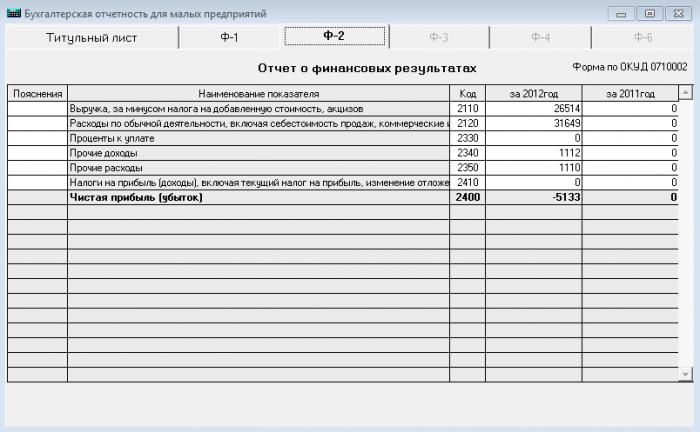Opening your own business is a serious and laborious step. It is necessary to determine the activity, develop a plan, find the means to start and many other organizational issues. The success of a business depends on a huge number of factors. And among them, one of the first lines is taken by a good choice of the legal form, the method of accounting and the tax system. This article discusses what a small business is, who can be considered such, as well as the features of its reporting.

What is called a small business
A small enterprise is an organization registered as an LLC, peasant farm or individual entrepreneur that meets the following parameters specified in the law "On Amending Certain Legislative Acts of the Russian Federation on the Development of Small and Medium Enterprises in the Russian Federation" dated 06.29.2015. According to the amendments, a small enterprise is an organization whose annual revenue (for the previous reporting year) from the sale of goods and services did not exceed 800 million rubles, the average number of employees is not more than 100 people, and the share of foreign investment does not exceed 49% in the authorized capital.
Benefits for Small Businesses
The government in recent years has been actively promoting bills that should make life easier for small and medium-sized businesses. All this is done so that our own Russian market develops, replaces imported goods, reduces the number of unemployed, and so on. Due to this, a small enterprise has several advantages:
- for individual entrepreneurs the rate on the simplified tax system is reduced to 9%;
- submission of the annual report to the Federal Tax Service does not require a sworn auditor;
- There is no need to pay advance payments of income tax;
- financial statements can be maintained according to a simplified system;
- if the amount of revenue for the last quarter exceeded 2 million rubles, the company is exempt from VAT;
- it is possible to apply a simplified taxation system;
- the cash limit has been abolished, for the storage of any amount at the cash desk of the organization, the order of the head is enough;
- the opportunity to take advantage of government subsidies as a matter of priority;
- Until 01.07.2018, small business representatives can acquire state or municipal property as a priority;
- non-tax inspection times are reduced;
- companies operating in the scientific, industrial and social sectors have tax holidays.
As can be seen from the list above, small and medium-sized enterprises enjoy a wide range of benefits and advantages. Next, we will analyze what it is nevertheless necessary to present to the state, which reports to submit and how to do it.

Reports for small businesses
A small business is required to provide only three reports: a balance sheet, a report on the intended use of cash, and a report on financial results. It is worth noting that if the tax authority formally requests any other information, the organization will be required to provide it.
They are not entitled to hand over a simplified package of documents to companies related to construction, related to the state and public procurement, as well as legal organizations.

Actions Before Balancing
Before compiling the balance sheet of a small enterprise, a number of actions should be taken.All the information important for accounting should be fixed in the accounting policy of the organization: working chart of accounts, document forms, rules for document management, frequency and rules for conducting internal audits and the persons responsible for them, methods for assessing property, inventories, assets and liabilities. If something is not reflected in the accounting policy, the organization is not entitled to put it into practice. For example, from the beginning of this year, small businesses are allowed to accept materials at suppliers' prices, excluding associated costs. All materials can be written off at a time. If this opportunity is not reflected in the accounting policy, its use will entail serious violations. An accounting policy document is generated annually and in the case of a tax audit is a reason for sanctions.
Also, before drawing up the balance sheet of a small enterprise, it is necessary to make sure that accounting is correct, business transactions are reflected, the presence of supporting documents and the correctness of filling in the details. In order to ensure compliance with all these points, a commission is created from the responsible persons, which checks the lawfulness and correctness of all points. If everything turned out favorably and no errors were found, you can proceed with the reformation of the balance.

Small Business Accounting
The reformation of the balance implies the sequential closure of accounts 90, 91 and 99. After these accounts are closed, the final result of the organization’s activity for the last reporting period is reflected in account 84. If the amount is reflected in the credit of the account, profit is made. Accordingly, if the debit - the company suffered losses. After these steps, the procedure is considered completed, and the accountant can begin to prepare reports for the tax service.
The reporting of small enterprises in 2016 did not change in terms of composition, form and necessary balance details. The heading of the document should contain the date (the last day of the year for which the company reports), the name of the business entity, codes, classifiers and TIN, units of measurement and legal address. The asset reflects fixed and non-current assets, construction in progress, intangible assets, non-current financial assets, goods for sale, cash on hand and in settlement accounts, as well as short-term financial investments (receivables). The liability reflects liabilities: capital and reserves, loans (short-term and long-term) and accounts payable. The asset and liability balance at the end of the year should match. If the amounts are different, then somewhere in the calculations an error was lost.

Income statement
A small enterprise is a form of organization that, in addition to the balance sheet, must provide a report on financial results. Previously, this document was called an income statement. It can be formed only after the completion of the reformation of the balance sheet. Contains row-based metrics for the reporting and previous period. Each line has its own name and explanatory classifier. If more detailed explanations are required for the amount, it is described below in the appendix to the report. A small business in 2017 in this document should report on the following parameters: revenue, cost of sales, gross profit and loss, expenses on commercial activities and on managing the organization, what profit or loss the organization incurred from the sale of goods and services, what profit came from participating in other organizations, interest on liabilities from payables and receivables, as well as all other income and expenses. It also indicates the amount of profit before tax, net profit and the tax amount in a separate line.
Also, reports of a small enterprise on financial results for the period include the inclusion of lines containing indicators on the recalculation of the value of assets, changes in the amount of liabilities, including deferred, as well as reflecting other incomes and losses of funds that are not included in the income and expenses of the main activities of the organization .

Cash Use Report
The report on the targeted use of funds is not mandatory for all small businesses without exception. So which small businesses should pass this report? The answer is simple: those who received these targeted funds. A small enterprise is an activity that is now actively sponsored and subsidized by the state. If it was decided to use these subsidies, then it will be necessary to report on the funds received in detail and thoroughly. The government does not help financially just like that, it must be sure that the money invested in small business will go exactly for the purposes that were provided. By its structure, this document resembles a report on financial results. All indicators are also written line by line, accompanied by a numerical classifier and explanations. The report should fully reflect all the items on which the target funds were spent.

Reporting requirements
Small business reports are regulated by a number of state regulations. Their filling provides for compliance with the following requirements:
- numerical indicators should be indicated in thousands of rubles;
- dashes must be put in column-free columns;
- all indicators with a negative value should be indicated in parentheses;
- balance for periods must coincide, that is, balances at the beginning and end of the period;
- the reports for the period should include indicators for all branches and divisions, if any;
- indicators must be included in the submitted reports for previous reporting periods so that tax officials can compare the data;
- details of the requirements should fully satisfy the interested parties;
- various structural data should be provided separately from each other to facilitate understanding of the information.
How, where and when reporting is submitted
Despite the simplified reporting forms, there are no concessions in terms of deadlines for small organizations. All reports must be submitted by March 31, that is, before the end of the first quarter following the reporting one. The bodies interested in the reporting information are the tax inspectorate and state statistics. Small enterprises provide documents both to the tax control authorities and a duplicate package to the State Statistics Committee.
There are three ways to submit reports:
- The first - personally appearing in the above regulatory authorities;
- The second - through an electronic reporting system using Internet technologies and a key;
- The third is the transfer of documents using the registered postal service with an attached content description.
To date, all three methods are used with approximately the same frequency. A return to the tax authority personally guarantees that the documents will be accepted on time, not lost in the delivery process, and will also go exactly where they should. In addition, upon personal appearance, the organization immediately receives its copy of the report with the visa on the date of adoption of the package of documents. An electronic method using network technologies allows you to submit reports without leaving your office, without long queues and communication with a large number of inspectors. However, it should be remembered that in order to use this method, you must acquire an identifying electronic key.The third method also does not force accountants and managers to defend huge queues in the inspection, but does not guarantee that the reports will reach their destination on time. This method is more appropriate for organizations located far from the regional center where the tax authority is located. For example, in rural areas reporting postings are very popular.
Sanctions for late submission of reports
The tax control authorities carefully monitor compliance with the deadlines for reporting. Late submission of financial statements is fined. Its size is determined in the amount of five percent of the tax amount, which is indicated in the declaration. And while this can not be less than 1 thousand rubles. In addition, the officials responsible for the submission of declarations are fined, that is, the head and accountants. The amount of the fine for individuals is from 200 to 500 rubles for each expired document. Thus, delayed declarations on income taxes, land, transport and property taxes are penalized. Also, tax declarations that are not submitted on time are fined under the following taxation systems: USN, UTN, UTII. Reports to the Pension Fund and the Social Insurance Fund are fined in this way - 5% of the amount of contributions that must be paid for the last 3 months.
Delay in delivery of the balance to the tax office is punishable by a fine of 200 rubles for the organization and 300-500 rubles to the responsible person. The delay in putting the balance in the statistics bodies to the enterprise will cost 3-5 thousand rubles. Responsible persons will also pay from 300 to 500 rubles.
To summarize
Opening a small business has several advantages for a novice businessman. Simplified reports and bookkeeping can be done without an economic education, so at first you can not open a job as an accountant. At the same time, state subsidies aimed at the development of Russian entrepreneurship are provided for in many areas of activity. If you conduct activities in accordance with the law and prepare reports on time, the novice entrepreneur will not have any problems with regulatory authorities. Even if some indicators are initially calculated incorrectly, there is the possibility of adjusting the data in the next reporting periods.